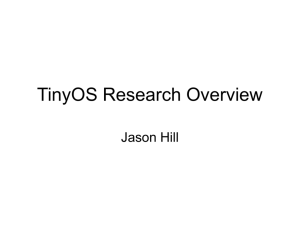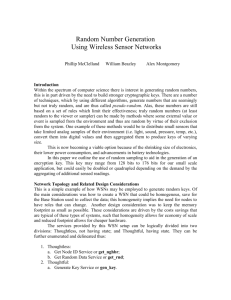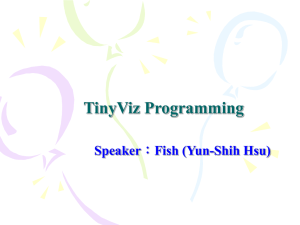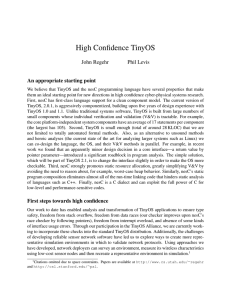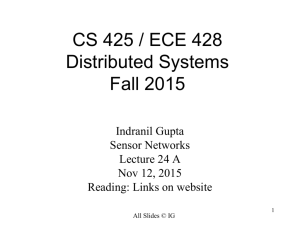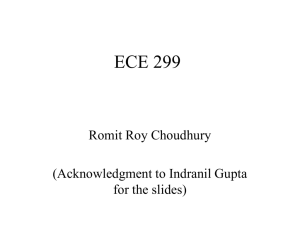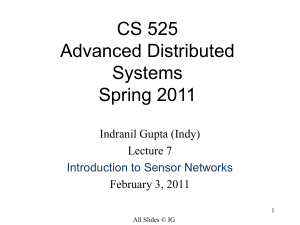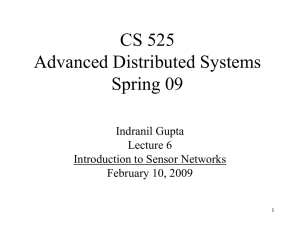Sensor Networks Simulation
advertisement
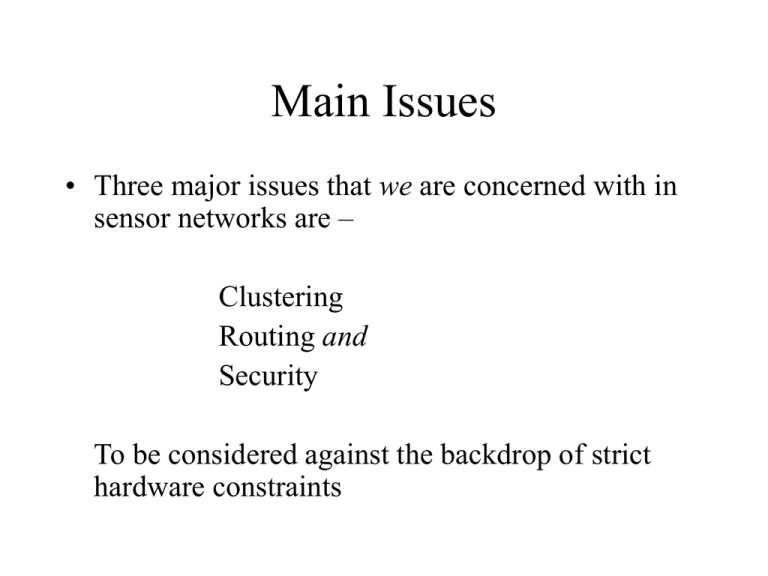
Main Issues
• Three major issues that we are concerned with in
sensor networks are –
Clustering
Routing and
Security
To be considered against the backdrop of strict
hardware constraints
• Clustering
Dividing the network
into clusters after
deployment, and
choosing a cluster
head
• Routing
Deciding routing paths
for communication
between the base
station and the cluster
heads
• Security
Ensuring that the
communications are
secure
(Particularly important
in military
applications)
Goals
• Implement clustering,
routing, and security
algorithms developed by
the team
• Run test cases for different
parameters of a sensor
network
• For example number of
nodes in the network,
number of clusters
• Run different test
cases for ‘abnormal’
conditions to check the
robustness of the
algorithms
• For example a cluster
head dying out
without being able to
inform other cluster
members
How do we do this ?
…simulation
The software
• TinyOS
TinyOS is a component-based runtime environment
designed to provide support for deeply embedded
systems which require concurrency intensive
operations while constrained by minimal hardware
resources
--- TinyOS website at UC Berkeley
• The programming language – nesC, a programming
language for Network Embedded Systems
nesC
Application
A NesC application consists of one or more components, linked together
to form a runnable executable.
Component
Components are the basic building blocks for NesC applications.
Components are of two types: modules and configurations.
Module
A module is a NesC component consisting of application code in a C-like
syntax.
Configuration
A configuration is a component that "wires" other components together.
Every NesC application has a single top-level configuration that specifies
the set of components in the application and how they invoke one another.
Configuration
Module 1
Module 2
Module n
TOSSIM
• TOSSIM - The TinyOS simulator
Allows nesC code to be compiled and
executed on a Linux machine
Even has a simple GUI to it
Example Simulation
• Consider two motes (ID 0 and1) communicating
with each other as follows:
Mote 0 maintains a 16-bit integral counter, and
at every tick of the counter it broadcasts the
value of the counter across it’s RF
communication channel to Mote 1
Example Simulation
The format of the data transmitted/received over the radio channel
typedef struct TOS_Msg
{
/* The following fields are transmitted/received on the radio. */
uint16_t addr;
uint8_t type;
uint8_t group;
uint8_t length;
int8_t data[TOSH_DATA_LENGTH];
/* The following fields are not actually transmitted or received
* on the radio! They are used for internal accounting only.
* The reason they are in this structure is that the AM interface
* requires them to be part of the TOS_Msg that is passed to
* send/receive operations.
*/
uint16_t strength;
uint8_t ack;
uint16_t time;
} TOS_Msg;
Example Simulation
Format of data
Mote
0
Data
ff ff 04 7D 08 04 00 00
Mote
Data
1
ff ff 04 7D 08 04 00 00
ff ff = addr (broadcast)
04
= type (handler ID)
7D
= group (cluster ID)
08
= length
040000= Data
Thank You
Questions ?

